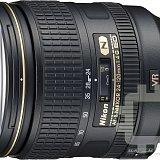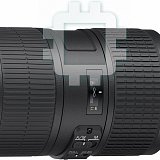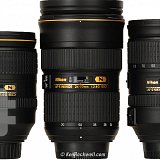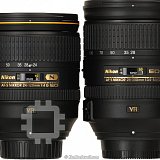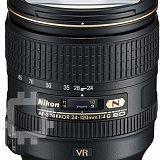Nikon 24-120MM F 4G ED AF-S VR ZOOM-NIKKOR: инструкция
Характеристики, спецификации
Инструкция к Объективу Nikon 24-120MM F 4G ED AF-S VR ZOOM-NIKKOR
Оглавление
- Примечания по безопасности использования
- Компоненты
- Основные возможности Совместимые фотокамеры и доступные функции
- Фокусировка
- Режим подавления вибраций (VR
- Примечания по использованию подавления вибрации
- Фокусировка, зуммирование и Использование бленды глубина резко изображаемого пространства Встроенная вспышка и виньетирование Установка диафрагмы
- Рекомендуемые фокусировочные экраны
- Уход за объективом Стандартн ые принадлежност и Дополнительн а я принадлежност ь
- Технические характеристики

AF-S NIKKOR 24-120mm f/4G ED VR
AF-S NIKKOR 24-120mm f/4G ED VR
Sv
使用説明書の内容が破損などによって判読できなくなったときは、
ニコンサービス機関にて新しい使用説明書をお求め下さい(有料)。
No reproduction in any form of this manual, in whole or in part
(except for brief quotation in critical articles or reviews), may be
P. 2
P. 76
made without written authorization from NIKON CORPORATION.
Pg. 12
P. 86
S. 26
STR. 96
P. 36
STR. 106
P. 46
P. 116
S. 56
P. 126
Printed in Thailand
CTP. 66
P. 136
7MAA69E3-04SG12
©
2010 Nikon Corporation

安全上のご注意
Jp
ご使用の前に「安全上のご注意」をよくお読みのうえ、正しくお使いください。この「安全上のご注意」は製品を
安全に正しく使用していただき、あなたや他の人々への危害や財産への損害を未然に防止するために、重要な内容
を記載しています。お読みになった後は、お使いになる方がいつでも見られる所に必ず保管してください。
表示について
表示と意味は次のようになっています。
この表示を無視して、誤った取り扱いをすると、人が死亡または重傷を負う可能性が想定される
警告
内容を示しています。
この表示を無視して、誤った取り扱いをすると、人が傷害を負う可能性が想定される内容および
注意
物的損害の発生が想定される内容を示しています。
お守りいただく内容の種類を、次の絵表示で区分し、説明しています。
絵表示の例
記号は、注意(警告を含む)を促す内容を告げるものです。図の中や近くに具体的な注意内容
(左図の場合は感電注意)が描かれています。
記号は、禁止の行為(してはいけないこと)を告げるものです。図の中や近くに具体的な禁止内容
(左図の場合は分解禁止)が描かれています。
●記号は、行為を強制すること(必ずすること)を告げるものです。図の中や近くに具体的な強制内容
(左図の場合は電池を取り出す)が描かれています。
2

警告
注意
Jp
分解したり、修理や改造をしないこと
ぬれた手でさわらないこと
En
感電したり、異常動作をしてケガの原因となります。
感電の原因になることがあります。
分解禁止
感電注意
製品は幼児の手の届かないところに置くこと
De
落下などによって破損し、内部が露出した
ケガの原因になることがあります。
接触禁止
ときは、露出部に手を触れないこと
放置禁止
Fr
感電したり、破損部でケガをする原因となります。
逆光撮影では、太陽を画角から充分にずら
カメラの電池を抜いて、販売店またはニコンサー
すこと
すぐに
ビス機関に修理を依頼してください。
Es
修理依頼を
太陽光がカメラ内部で焦点を結び、火災の原因に
使用注意
なることがあります。画角から太陽をわずかに外
熱くなる、煙が出る、こげ臭いなどの異常時
しても火災の原因になることがあります。
Se
は、速やかにカメラの電池を取り出すこと
電池を取る
使用しないときは、レンズにキャップをつけ
そのまま使用すると火災、やけどの原因となりま
Ru
るか太陽光のあたらない所に保管すること
す。電池を取り出す際、やけどに充分注意してく
太陽光が焦点を結び、火災の原因になることがあ
ださい。電池を抜いて、販売店またはニコンサー
保管注意
すぐに
Nl
ります。
修理依頼を
ビス機関に修理を依頼してください。
三脚にカメラやレンズを取り付けたまま移動
水につけたり、水をかけたり、雨にぬらし
It
しないこと
たりしないこと
水かけ禁止
転倒したりぶつけたりしてケガの原因になること
発火したり感電の原因となります。
移動注意
Cz
があります。
引火、爆発のおそれのある場所では使用し
窓を閉め切った自動車の中や直射日光が当
ないこと
Sk
たる場所など、異常に温度が高くなる場所
プロパンガス・ガソリンなど引火性ガスや粉塵の
に放置しないこと
使用禁止
発生する場所で使用すると、爆発や火災の原因と
放置禁止
Ck
内部の部品に悪い影響を与え、火災の原因となる
なります。
ことがあります。
レンズまたはカメラで直接太陽や強い光を
Ch
見ないこと
見ないこと
失明や視力障害の原因となります。
Kr
3

■各部の名称
Jp
1フード(P.8)
En
2フード取り付け指標(P.8)
3フードセット指標(P.8)
De
4フード着脱指標(P.8)
Fr
5ズームリング(P.8)
6焦点距離目盛
Es
7焦点距離目盛指標
8距離目盛(P.8)
Se
9距離目盛基準線
Ru
0フォーカスリング(P.6)
!レンズ着脱指標
Nl
@レンズマウントゴムリング
(P.10)
It
#CPU 信号接点(P.10)
Cz
$フォーカスモード切り換え
スイッチ(P.6)
Sk
%手ブレ補正スイッチ(P.7)
Ck
^手ブレ補正モード切り換え
スイッチ(P.7)
Ch
( ):参照頁
Kr
4

このたびはニッコールレンズをお買い上げくださいまして、誠にありがとうございます。ご使用の前に、
Jp
この使用説明書をよくお読みの上、正しくお使いください。また、カメラの使用説明書もご覧ください。
En
■主な特長
■使用できる機能
●
ナノクリスタルコート(Nano Crystal Coat)を一
カメラによって、使用できる機能には制限・制約があ
De
部のレンズに施したことにより、強い太陽光が当た
りますので、カメラの使用説明書でもご確認ください。
Fr
る屋外撮影から、スポットライトのある室内撮影ま
機 能
露出(撮影)モード
カメラ
※1
で、クリアーで抜けの良い画像を提供します。
VR AF P
SAM
Es
●
手ブレ補正機能(VRⅡ)を使用すると、使わないと
FX フォーマット /DX フォーマットの
※
ニコンデジタル一眼レフカメラ、
きと比べ約 4 段分
シャッタースピードを遅くして
○○ ○○○○
F6、F5、F100、F80
シリーズ
、
Se
撮影できるため、シャッタースピードの選択範囲が
ニコン
U2、
ニコン
U
広がり、幅広い領域で手持ち撮影が可能です。(※ 当
※2
プロネア
600i、
プロネア
S
×○ ○○○○
Ru
社測定条件によります。また、手ブレ補正効果は、
F4
シリーズ
、F90X
シリーズ
、
×○ ○○××
撮影者や撮影条件によって異なります。)
F90
シリーズ
、F70D
Nl
ご注意
ニコン
Us、F60D、F50D、
×× ○○○○
F-401
シリーズ
●
It
DX フォーマットのニコンデジタル一眼レフカメラ
F-801
シリーズ
、F-601M × × ○ ○ × ×
(D300 シ リー ズ、D7000 など)に装着すると、
F3AF、F-601、F-501、
Cz
対角線画角は 61°―13°20′となり、35mm 判換算
×× ××××
MF
カメラ
(F-601M を除く)
では焦点距離約 36mm―180mm 相当のレンズに
○:
使用可
×:
使用不可
VR:
手ブレ補正
AF:
オートフォーカス
Sk
なります。
※ 1:P には AUTO(オート)モード、イメージプログラ
Ck
ムモード(シーンモード)を含みます。
※ 2:M モードの設定はありません。
Ch
Kr
5

■ピント合わせの方法
■手ブレ補正機能(VRⅡ)
Jp
ご使用のカメラや撮影目的によって、下表のようなピ
手ブレ補正機能の概念図
En
ント合わせが選択できます。
高
M/A(マニュアル優先オートフォーカスモード)の使
De
激しい揺れ
い方
例)乗り物等
a
レンズのフォーカスモード切り換えスイッチを
手ブレ
周
での揺れ
Fr
[M/A] にセットします。
波
b
AF(オートフォーカス)撮影時、カメラのシャッター
数
Es
ボタンを半押ししたまま、あるいはAF作動(AF-ON)
流し撮り(パンニング)
ボタンを保持したまま、フォーカスリングを手で回
Se
転させると、瞬時にMF(マニュアルフォーカス)撮影
低
が行えます。
Ru
振 幅
大小
c
カメラのシャッターボタンの半押しやAF作動
NORMALモードで対応
ACTIVEモードで対応
(AF-ON)ボタンを再度操作するとAF(オートフォー
Nl
カス)で撮影が可能となります。
NORMAL モードまたは
手ブレ補正
ACTIVE モードで対応
It
流し撮りでの手ブレ補正 NORMAL モードで対応
激しい揺れでの手ブレ補正 ACTIVE モードで対応
Cz
カメラの
レンズのフォーカスモード
Sk
カメラ
フォーカスモード
M/A M
FX フォーマット /DX フォーマットのニコンデジタル一眼
マニュアル優先
マニュアルフォーカス
AF
Ck
レフカメラ、F6、F5、F4シリーズ、F100、F90X シリーズ、
オートフォーカス
(フォーカスエイド可)
F90 シリーズ、F80 シリーズ、F70D、ニコン U2、
マニュアルフォーカス
MF
Ch
ニコン U、プロネア 600i、プロネア S
(フォーカスエイド可)
ニコン Us、F60D、F50D、F-801 シリーズ、
AF
マニュアルフォーカス
Kr
F-401 シリーズ、F-601M
MF
(F-601M を除きフォーカスエイド可)
6

手ブレ補正スイッチの使い方
●
シャッターボタンを半押し後、ファインダー像が安
Jp
ON:シャッターボタンを半押しする
定してから撮影することをおすすめします。
と、手ブレを補正します。ファイン
●
手ブレ補正の原理上、シャッターレリーズ後にファ
En
ダー像のブレも補正するため、ピン
インダー像がわずかに動くことがありますが、異常
ト合わせが容易で、フレーミングし
ではありません。
De
やすくなります。
●
流し撮りする場合は、必ず NORMAL モードにして
OFF:手ブレを補正しません。
ください。NORMAL モードでは、流し撮りなどで
Fr
カメラの向きを大きく変えた場合、流した方向の手
手ブレ補正モード切り換えスイッチの使い方
ブレ補正は機能しません。例えば、横方向に流し撮
手ブレ補正スイッチを[ON]にし、手ブレ補正モード
Es
りすると、縦方向の手ブレだけが補正されます。
切り換えスイッチを設定します。
●
手ブレ補正中にカメラの電源を OFF にしたり、レン
Se
NORMAL:主に、通常の手ブレを補
ズを取り外したりしないでください。(その状態でレ
正します。流し撮りでも手ブレを補
ンズを振るとカタカタ音がすることがありますが、
Ru
正します。
故障ではありません。カメラの電源を再度 ON にす
ACTIVE:乗り物に乗っている等、揺
れば、音は消えます。)
Nl
れの激しい条件でのブレから通常の
●
内蔵フラッシュ搭載のカメラで、内蔵フラッシュ充
手ブレまで補正します。このモード
電中は、手ブレ補正は行いません。
It
では流し撮り自動検出は行いません。
●
三脚を使用するときは、手ブレ補正スイッチを[OFF]
手ブレ補正使用時のご注意
にしてください。ただし、三脚を使っても雲台を固
Cz
●
手ブレ補正が使用できないカメラ(P.5)では、必ず、
定しないときや、一脚を使用するときには、スイッ
手ブレ補正スイッチを[OFF]にしてください。特
チを[ON]にすることをおすすめします。
Sk
にプロネア 600i では、このスイッチを[ON]にし
Ck
たままにすると、電池の消耗が早くなることがあり
ますのでご注意ください。
Ch
Kr
7

■ズーミングと被写界深度
■フードの使い方
Jp
撮影を行う場合は、ズームリングを回転させ(焦点距
画像に悪影響を及ぼす光線をカットし、レンズ面の保
En
離が変化します)構図を決めてから、ピント合わせを
護にも役立ちます。
行ってください。プレビュー(絞り込み)機構を持つ
取り付け方
De
カメラでは、撮影前にファインダー内で被写界深度を
●
フード着脱指標( )
確認できます。
とフードセット指標
Fr
●
このレンズは IF(ニコン内焦)方式を採用しています。
(
)が合っている
IF 方式は、撮影距離が短くなるにしたがって焦点距
ことを確認してくだ
Es
離が短くなります。
さい(❸)。
●
距離目盛は目安であり、被写体までの距離を保証す
Se
るものではありません。また、遠景撮影でも被写界
Ru
深度などの影響により∞マークに届かない位置でピ
●
ントが合う場合があります。
フード先端を強くつかむと着脱が困難になります。
Nl
●
着脱の際は、フード取り付け指標(
)付近を持っ
詳しい被写界深度は、被写界深度表(P.156)をご
て回転させてください。
覧ください。
It
●
フードが正しく取り付けられないと撮影画面にケラ
■絞り値の設定
レを生じますのでご注意ください。
Cz
●
収納時はフードを逆向きにしてレンズに取り付けら
絞り値は、カメラ側で設定してください。
れます。着脱の際は、フードセット指標(
)付近
Sk
を持って回転させてください。
Ck
Ch
Kr
8

■カメラの内蔵フラッシュ使用時のご注意
カメラ
ケラレなく撮影できる焦点距離と撮影距離
Jp
●焦点距離 70mm では撮影距離 1.5m以上
●
撮影距離 0.6m 以上で使用してください。
二コン U、二コン Us
●焦点距離 85mm 以上では撮影距離 1m以上
●
ケラレを防止するために、レンズのフードは取り外
En
●焦点距離 50mm では撮影距離 1.5m以上
して使用してください。
二コン U2
●焦点距離 70mm では撮影距離 1m以上
●焦点距離 85mm 以上では制約なし
※カメラの内蔵フラッシュのケラレとは、フラッシュ
De
の光がレンズの先端でさえぎられて影になり、写真
■
ファインダースクリーンとの組み合わせ
に映り込む現象です。
Fr
カメラ
ケラレなく撮影できる焦点距離と撮影距離
スクリーン
EC-B
G1
Es
●焦点距離 28mm では撮影距離 1m 以上
ABCE
G3 G4
JLMU
D800 シリーズ
●焦点距離 35mm 以上では制約なし
EC-E
G2
カメラ
●焦点距離 24mm では撮影距離 3m 以上
Se
D700(FX フォーマット時)
●焦点距離 35mm 以上では制約なし
F6 ◎ ◎―◎ ― ―――◎ ◎
D300 シリーズ、
●焦点距離 24mm では撮影距離 1m 以上
Ru
D200、D100
●焦点距離 35mm 以上では制約なし
F5+DP-30
◎ ◎○◎ ◎ ○ ◎ ◎
D90、D80、
●焦点距離 24mm では撮影距離 1.5m 以上
◎
◎
D70 シリーズ、D50
●焦点距離 35mm 以上では制約なし
F5+DA-30
◎◎◎ ◎
(+ 0.5)
(+ 0.5)
Nl
●焦点距離 24mm では撮影距離 1.5m 以上
D5100
●焦点距離 28mm 以上では制約なし
構図の決定やピント合わせの目的には
It
D5000、D3100、
●焦点距離 24mm では撮影距離 2.5m 以上
◎ : 好適です。
D3000、D60、
●焦点距離 35mm 以上では制約なし
○ :視野の一部が多少見にくくなりますが、撮影結果に
D40 シリーズ
Cz
は全く影響がありません。
●焦点距離 35mm では撮影距離 1.5m 以上
F80 シリーズ
:各カメラに存在しないファインダースクリーンです。
●焦点距離 50mm 以上では制約なし
Sk
():中央部重点測光時の補正値です。F6 カメラの場合、
●焦点距離 50mm では撮影距離 1m以上
F70D
測光値の補正は、カメラのカスタムメニュー「b6:
●焦点距離 70mm 以上では制約なし
スクリーン補正」を「BorE 以外」にセットして行
Ck
●焦点距離 50mm では撮影距離 3m以上
F60D
●焦点距離 70mm では撮影距離 1.5m以上
います。B 型および E 型以外を使用する場合は、補
●焦点距離 85mm 以上では撮影距離 1m以上
正量が 0 でも、「BorE 以外」にセットしてください。
Ch
●焦点距離 70mm では撮影距離 2m以上
F5 カメラの場合は、カスタムセッティング No.18
F50D、
●焦点距離 85mm では撮影距離 1.5m以上
の設定で測光値の補正を行います。詳しくはカメラ
F-401 シリーズ
●焦点距離 120mm では撮影距離 1m以上
Kr
の使用説明書をご覧ください。
9

空欄:使用不適当です。ただし、M スクリーンの場合、撮
●
レンズを長期間使用しないときは、カビやサビを防
Jp
影倍率 1/1 倍以上の近接撮影に用いるため、この限
ぐために、高温多湿のところを避けて風通しのよい
りではありません。
場所に保管してください。また、直射日光のあたる
En
ご注意
ところ、ナフタリンや樟脳のあるところも避けてく
●
F5カメラの場合、マルチパターン測光は、EC-B、
ださい。
De
EC-E、B、E、J、A、L スクリーンのみ可能です。
●
レンズを水に濡らすと、部品がサビつくなどして故
Fr
■
レンズのお手入れと取り扱い上のご注意
障の原因となりますのでご注意ください。
●
ストーブの前など、高温になるところに置かないでく
●
フードをレンズに装着した状態で、フードだけを持
ださい。極端に温度が高くなると、外観の一部に使用
Es
たないでください。
している強化プラスチックが変形することがあります。
●
CPU 信号接点は汚さないようにご注意ください。
Se
●
レンズマウントゴムリングが破損した場合は、その
■付属アクセサリー
まま使用せず販売店またはニコンサービス機関に修
●
Ru
77mm スプリング式レンズキャップLC-77
理を依頼してください。
●
裏ぶたLF-4
●
レンズ面の清掃は、ホコリを拭う程度にしてくださ
Nl
●
バヨネットフードHB-53
い。指紋がついたときは、柔らかい清潔な木綿の布
●
ソフトケースCL-1218
に無水アルコール(エタノール)または市販のレン
It
ズクリーナーを少量湿らせ、レンズの中心から外周
■別売アクセサリー
へ渦巻状に、拭きムラ、拭き残りのないように注意
Cz
●
77mm ネジ込み式フィルター
して拭いてください。
●
シンナーやベンジンなどの有機溶剤は絶対に使用し
Sk
ないでください。
●
レンズ表面の汚れや傷を防ぐためには、NC フィルター
Ck
をお使いいただけます。また、レンズのフードも役
立ちます。
Ch
●
レンズをケースに入れるときは、必ずレンズキャッ
プと裏ぶたを取り付けてください。
Kr
10

■仕 様
最短撮影距離: 撮像面から 0.45m(ズーム全域)
Jp
型式: ニコン F マウント CPU 内蔵 G タイ
絞り羽根枚数: 9 枚(円形絞り)
プ、AF-S ズームレンズ
絞り方式: 自動絞り
En
焦点距離: 24―120mm
絞りの範囲: f/4―22
De
最大口径比: 1:4
測光方式: CPU 連動方式のカメラでは開放測光
レンズ構成: 13群 17枚(EDレンズ 2枚、非
アタッチメントサイズ:
77mm(P=0.75mm)
Fr
球面レンズ 3枚、ナノクリスタルコ
寸法: 約 84mm(最大径)× 103.5mm
ート)
(バヨネットマウント基準面からレ
Es
画角: 84°―20°20′(35mm判一眼レフ
ンズ先端まで)
カメラ、FXフォーマットのデ
Se
質量: 約 710g
ジタル一眼レフカメラ)
61°―13°20′(DXフォーマット
※仕様、外観の一部を、改善のため予告なく変更する
Ru
のデジタル一眼レフカメラ)
ことがあります。
71°―16°20′(IX240カメラ)
Nl
焦点距離目盛: 24、28、35、50、70、85、
120mm
It
撮影距離情報: カメラへの撮影距離情報を出力可能
Cz
ズーミング: ズームリングによる回転式
ピント合わせ: IF(ニコン内焦)方式、超音波モーター
Sk
によるオートフォーカス、マニュア
ルフォーカス可能
Ck
手ブレ補正: ボイスコイルモーター(VCM)に
よるレンズシフト方式
Ch
撮影距離目盛: ∞〜 0.45m(2ft併記)
Kr
11

Jp
Notes on Safety Operations
CAUTION
En
Do not disassemble
Do not use the camera or lens in the
De
Touching the internal parts of the camera or
presence of flammable gas
lens could result in injury. Repairs should be
Operating electronic equipment in the
Fr
performed only by qualified technicians.
presence of flammable gas could result in an
Should the camera or lens break open as the
explosion or fire.
Es
result of a fall or other accident, take the
Do not look at the sun through the
product to a Nikon-authorized service
Se
lens or viewfinder
representative for inspection after
Viewing the sun or other strong light sources
Ru
unplugging the product and/or removing the
battery.
through the lens or viewfinder could cause
Nl
permanent visual impairment.
Turn off immediately in the event of
Keep out of reach of children
It
malfunction
Particular care should be taken to prevent
Should you notice smoke or an unusual smell
Cz
infants from putting the batteries or other
coming from the camera or lens, remove the
small parts into their mouths.
battery immediately, taking care to avoid
Sk
burns. Continued operation could result in
injury.
Ck
After removing or disconnecting the power
Ch
source, take the product to a Nikon-
authorized service representative for
Kr
inspection.
12

Jp
En
Observe the following precautions
when handling the camera and lens
De
• Keep the camera and lens unit dry. Failure
Fr
to do so could result in fire or electric
shock.
Es
• Do not handle or touch the camera or lens
unit with wet hands. Failure to do so could
Se
result in electric shock.
• When shooting with back-lighting, do not
Ru
point the lens at the sun or allow sunlight
to pass directly down the lens as this may
Nl
cause the camera to overheat and possibly
It
cause a fire.
• When the lens will not be used for an
Cz
extended period of time, attach both front
and rear lens caps and store the lens away
Sk
from direct sunlight. Failure to do so could
result in a fire, as the lens may focus
Ck
sunlight onto a flammable object.
Ch
Kr
13

Nomenclature
Jp
1 Lens hood (pg. 20)
En
2 Lens hood attachment
index (pg. 20)
De
3 Lens hood setting index
(pg. 20)
Fr
4 Lens hood mounting
index (pg. 20)
Es
5 Zoom ring (pg. 20)
Se
6 Focal length scale
7 Focal length scale index
Ru
8 Distance scale (pg. 20)
9 Distance index line
Nl
0 Focus ring (pg. 16)
It
! Mounting index
@ Lens mount rubber
Cz
gasket (pg. 23)
# CPU contacts (pg. 23)
Sk
$ Focus mode switch
(pg. 16)
Ck
% Vibration reduction
ON/OFF switch (pg. 18)
Ch
^ Vibration reduction
Kr
mode switch (pg. 18)
( ): reference page
14

Thank you for purchasing the AF-S NIKKOR 24-120mm f/4G ED VR lens. Before using this
Jp
lens, please read these instructions and refer to your camera's user's manual.
Major features
Usable cameras and available
En
• The Nano Crystal Coat deposited on some
functions
De
of the lens elements ensures that fine, clear
There may be some restrictions or limitation
for available functions. Refer to camera’s
images can be reproduced under various
user’s manual for details.
Fr
shooting conditions, from the sunny
outdoors to spotlighted interior scenes.
Exposure
Es
Function
(shooting)
• By enabling vibration reduction (VR
Ⅱ
),
Cameras
mode
slower shutter speeds (approximately four
Se
*1
VR AF
P
SAM
stops*) can be used, thus increasing the
Nikon digital SLR (Nikon FX/DX
range of usable shutter speeds and zoom
Ru
format) cameras, F6, F5, F100,
positions, particularly when hand-holding
F80-Series/N80-Series*,
3 3 3 333
the camera. (*Based on results achieved
Nl
F75-Series/N75-Series*,
under Nikon measurement conditions. The
F65-Series/N65-Series*
It
effects of vibration reduction may vary
2
Pronea 600i/6i*, Pronea S*
—
33333
according to shooting conditions
Cz
and use.)
F4-Series, F90X/N90s*,
Important
F90-Series/N90*,
—
333
——
Sk
• When mounted on Nikon DX format digital
F70-Series/N70*
SLR cameras, such as the D300-Series and
F60-Series/N60*,
Ck
D7000, the lens’ angle of view becomes
F55-Series/N55-Series*,
——
3333
61°-13°20’ and its 35mm equivalent focal
F50-Series/N50*, F-401x/N5005*,
Ch
length is approx.
F-401s/N4004s*, F-401/N4004*
36-180mm.
Kr
15

Exposure
Focusing
Jp
Function
(shooting)
Set your camera focus mode according to
Cameras
mode
En
the chart below:
*1
VR AF
P
SAM
Autofocus with manual override
De
F-801s/N8008s*,
(M/A mode)
——
33
——
F-801/N8008*, F-601
M/N6000*
a
Set the lens focus mode switch to M/A.
Fr
F3AF, F-601/N6006*,
b
Autofocus is enabled, but autofocus
F-501/N2020**, Nikon MF
operation can be overridden by rotating
Es
— — — ———
cameras
the separate focus ring while pressing the
(except F-601
M/N6000*)
shutter-release button halfway, or by
Se
3: Possible —: Not possible
pressing the AF-ON button on the
camera.
Ru
VR: Vibration reduction AF: Autofocus
c
*Sold exclusively in the USA
Press the shutter-release button halfway
Nl
**Sold exclusively in the USA and Canada
or the AF-ON button once again to cancel
*1: P includes AUTO and Vari-Program System
manual focus and resume autofocus.
It
(Scene modes).
*2: Manual (M) is not available.
Cz
Sk
Ck
Ch
Kr
16

Camera
Jp
Lens focus mode switch
Cameras
focus
M/A M
En
mode
Manual focus
Nikon digital SLR (Nikon FX/DX format) cameras,
De
Autofocus with
(Electronic
F6, F5, F4-Series, F100, F90X/N90s*,
AF
manual override
rangefinder
F90-Series/N90*, F80-Series/N80-Series*,
Fr
can be used.)
F75-Series/N75-Series*, F70-Series/N70*,
Manual focus
F65-Series/N65-Series*, Pronea 600i/6i*,
Es
MF
(Electronic rangefinder can be
Pronea S
used.)
Se
F60-Series/N60*, F55-Series/N55-Series*,
Manual focus
F50-Series/N50*, F-801s/N8008s*,
Ru
AF
(Electronic rangefinder can be
F-801/N8008*, F-601
M/N6000*,
MF
used, except with the
F-401x/N5005*, F-401s/N4004s*,
Nl
F-601
M/N6000*)
F-401/N4004*
It
* Sold exclusively in the USA
Cz
Sk
Ck
Ch
Kr
17

Vibration reduction mode (VR
Ⅱ
)
Jp
Basic concept of vibration reduction
En
De
Camera shake
Fr
Es
Se
Ru
Nl
It
Cz
Sk
Ck
Ch
Kr
18
Strong
Strong
camera
camera
shake when taking
shake when taking
pictures from a
pictures from a
moving vehicle
Setting the vibration reduction ON/OFF
switch
ON: The effects of camera
High
shake are reduced while the
shutter-release button is
pressed halfway and also at
moving vehicle
the instant the shutter is
released. Because vibration is
reduced in the viewfinder,
Panning shots
Number of vibrations
auto/manual focusing and
exact framing of the subject
Weak
Strength of vibrations
Strong
Low
are easier.
Set the vibration reduction
Set the vibration reduction
OFF: The effects of camera
mode switch to NORMAL.
mode switch to ACTIVE.
shake are not reduced.
Set the vibration
Setting the vibration reduction mode
When taking
reduction mode switch
switch
pictures
to either NORMAL or
Set the vibration reduction ON/OFF switch to
ACTIVE.
ON and choose a vibration reduction mode
Set the vibration
with the vibration reduction mode switch.
When taking
reduction mode switch
NORMAL: The vibration
panning shots
to NORMAL.
reduction mechanism primarily
When taking
Set the vibration
reduces the effects of camera
pictures from a
reduction mode switch
shake. The effects of camera
moving vehicle
to ACTIVE.
shake are also reduced with
horizontal and vertical panning.

ACTIVE: The vibration reduction mechanism
wide arc, compensation for camera shake
Jp
reduces the effects of camera shake, such as
in the panning direction is not performed.
that which occurs when taking pictures from
For example, only the effects of vertical
En
a moving vehicle, whether it be normal or
camera shake is reduced with horizontal
more intense camera shake. In this mode,
panning.
De
camera shake is not automatically
• Do not turn the camera off or remove the
distinguished from panning motion.
Fr
lens from the camera while vibration
Notes on using vibration reduction
reduction is operating. Failure to observe
Es
• If this lens is used with cameras that do not
this note could result in the lens sounding
have the vibration reduction function (pg. 15),
and feeling as if an internal component is
Se
set the vibration reduction ON/OFF switch to
loose or broken when it is shaken. This is
OFF. With the Pronea 600i/6i camera, in
not a malfunction. Turn the camera on
Ru
particular, battery power may become quickly
again to correct this.
depleted if this switch is left ON.
• With cameras featuring a built-in flash,
Nl
• After pressing the shutter-release button
vibration reduction does not function while
the built-in flash is charging.
It
halfway, wait until the image in the
viewfinder stabilizes before pressing the
• When the camera is mounted on a tripod,
Cz
shutter-release button the rest of the way
set the vibration reduction ON/OFF switch
down.
to OFF. However, it is recommended that
Sk
• Due to the characteristics of the vibration
the switch be set to ON when using the
reduction mechanism, the image in the
camera on an unsecured tripod head or
Ck
viewfinder may be blurred after the shutter
with monopod.
is released. This is not a malfunction.
Ch
• When taking panning shots, be sure to set
the vibration reduction mode switch to
Kr
NORMAL. If the camera is panned in a
19

Focusing, zooming, and depth
Using the lens hood
Jp
of field
Lens hoods minimize stray light and protect the
En
Before focusing, rotate the zoom ring to
lens.
adjust the focal length until the desired
Attaching the hood
De
composition is framed. If your camera has a
• Be sure that the
depth-of-field preview (stop-down) button or
lens hood
Fr
lever, depth of field can be previewed
mounting index
through the camera viewfinder.
(
) is aligned with
Es
• This lens is equipped with the Internal
the lens hood
Focusing (IF) system. As the shooting
setting index (
)
Se
distance decreases, the focal length also
(3).
decreases.
Ru
• The distance scale does not indicate the
• To facilitate attachment or removal of
Nl
precise distance between the subject and
the hood, hold it by the base (near the lens
the camera. Values are approximate and
hood attachment index (
))
rather than its
It
should be used only as a general guide.
outer edge.
When shooting distant landscapes, depth
• If the lens hood is not correctly attached,
Cz
of field may influence operation and the
vignetting may occur.
subject may appear in focus at a position
• To store the lens hood, attach it in the
Sk
that is closer than infinity.
reverse position. To facilitate attachment or
• For more information, see page 156.
removal of the hood, hold it by the base
Ck
(near the lens hood setting index (
))
Setting the aperture
rather than its outer edge.
Ch
Use the camera to adjust the aperture
setting.
Kr
20

